The DirectX 12 Performance Preview: AMD, NVIDIA, & Star Swarm
by Ryan Smith on February 6, 2015 2:00 PM EST- Posted in
- GPUs
- AMD
- Microsoft
- NVIDIA
- DirectX 12
DirectX 12 vs. Mantle, Power Consumption
Although the bulk of our coverage today is going to be focused on DirectX 12 versus DirectX 11, we also wanted to take a moment to also stop and look at DirectX 12 and how it compares to AMD’s Mantle. Mantle offers an interesting point of contrast being that it has been in beta longer than DirectX 12, but also due to the fact that it’s an even lower level API than DirectX 12. Since Mantle only needs to work on AMD’s GPUs and can be tweaked for AMD’s architectures, it offers AMD the chance to exploit their GPUs in a few additional ways that a common, cross-vendor API like DirectX 12 cannot.
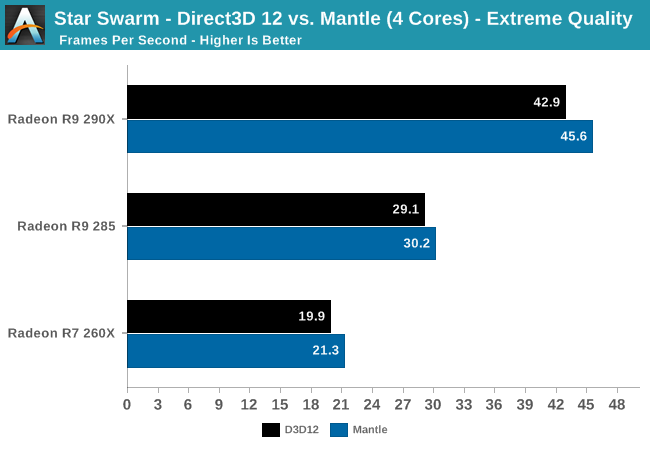
With 4 cores we find that AMD achieves better results with Mantle than DirectX 12 across the board. The gains are never very great – a few percent here and there – but they are consistent and just outside our window of variability for the Star Swarm benchmark. With such a small gain there are a number of factors that can possibly explain this outcome – better developed drivers, better developed application, further benefits of working with a known hardware platform – so we can’t credit any one factor. But it’s safe to say that at least in this one instance, at this time, Star Swarm’s Mantle rendering path produces even better results than its DirectX 12 path on AMD cards.
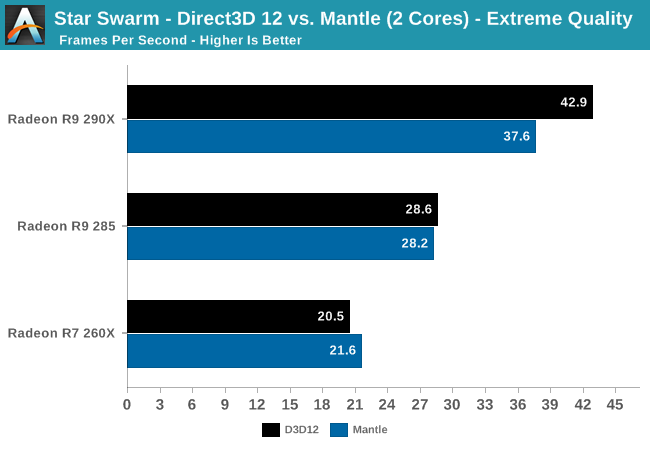
On the other hand, Mantle doesn’t seem to be able to accommodate a two-core situation as well, with the 290X seeing a small but distinct performance regression from switching to Mantle from DirectX 12. Though we didn’t have time to look at an AMD APU for this article, it would be interesting to see if this regression occurs on their 2M/4C parts as well as it does here; AMD is banking heavily on low-level APIs like Mantle to help level the CPU playing field with Intel, so if Mantle needs 4 CPU cores to fully spread its wings with faster cards, that might be a problem.

Diving deeper, we can see that part of the explanation for our Mantle performance regression may come from the batch submission process. DirectX 12 is unexpectedly well ahead of Mantle here, with batch submission taking on average a bit more than half as long as it does under Mantle. As batch submission times are highly correlated to CPU bottlenecking on Star Swarm, this would imply that DirectX 12 would bottleneck later than Mantle in this instance. That said, since we’re so strongly GPU-bound right now it’s not at all clear if either API would be CPU bottlenecked any time soon.
Update: Oxide Games has emailed us this evening with a bit more detail about what's going on under the hood, and why Mantle batch submission times are higher. When working with large numbers of very small batches, Star Swarm is capable of throwing enough work at the GPU such that the GPU's command processor becomes the bottleneck. For this reason the Mantle path includes an optimization routine for small batches (OptimizeSmallBatch=1), which trades GPU power for CPU power, doing a second pass on the batches in the CPU to combine some of them before submitting them to the GPU. This bypasses the command processor bottleneck, but it increases the amount of work the CPU needs to do (though note that in AMD's case, it's still several times faster than DX11).
This feature is enabled by default in our build, and by combining those small batches this is the likely reason that the Mantle path holds a slight performance edge over the DX12 path on our AMD cards. The tradeoff is that in a 2 core configuration, the extra CPU workload from the optimization pass is just enough to cause Star Swarm to start bottlenecking at the CPU again. For the time being this is a user-adjustable feature in Star Swarm, and Oxide notes that in any shipping game the small batch feature would likely be turned off by default on slower CPUs.
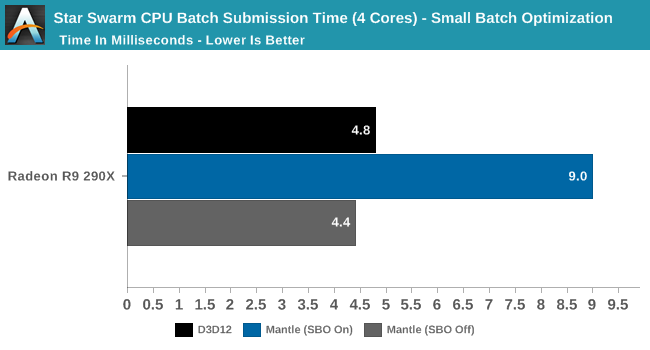
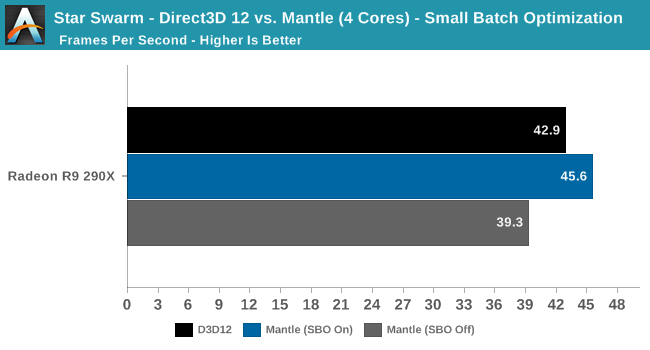
If we turn off the small batch optimization feature, what we find is that Mantle' s batch submission time drops nearly in half, to an average of 4.4ms. With the second pass removed, Mantle and DirectX 12 take roughly the same amount of time to submit batches in a single pass. However as Oxide noted, there is a performance hit; the Mantle rendering path's performance goes from being ahead of DirectX 12 to trailing it. So given sufficient CPU power to pay the price for batch optimization, it can have a signifcant impact (16%) on improving performance under Mantle.
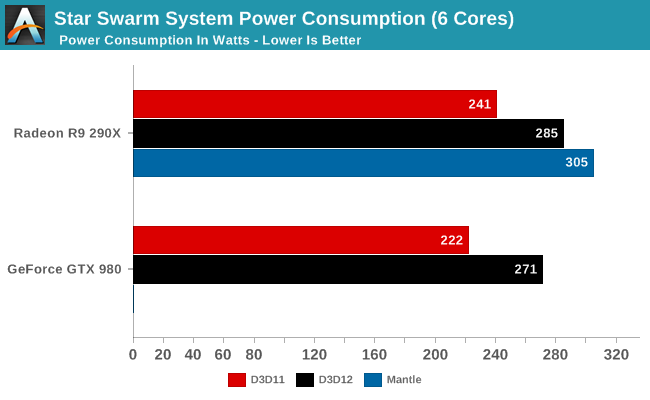
Finally, we wanted to take a quick look at power consumption among cards and APIs. To once again repeat what we said earlier, Star Swarm is an imperfect, non-deterministic benchmark, and coupled with the in-development status of DirectX 12 everything here is subject to change. However we thought this was interesting enough to include in our evaluation.
As expected, the increased throughput from DirectX 12 and Mantle drive up system power consumption. With the CPU no longer the bottleneck, the GPU never gets a chance to idle and video card power consumption ramps up to full load.










245 Comments
View All Comments
nikon133 - Sunday, February 8, 2015 - link
Windows Mobile was very strong smartphone/PDA OS, back in the pre iOS/Android days. I don't remember how it compared to Symbian, but I do remember that it overtook Palm (marketshare wise) at some point.Tablets, true... unless OP considers PDAs an early tablets.
sr1030nx - Sunday, February 8, 2015 - link
Win10 (and 8.1 to a very limited extent) uses universal apps, meaning you write an app once and it works across PC, tablet and phones.Also means you only need to buy an app once and you get it everywhere.
Christopher1 - Sunday, February 8, 2015 - link
The only person who is wrong here is you, hwangeruk. There are numerous people who have had that the whole "Free upgrade to Windows 10 from 7 and 8!" is directly due to Microsoft wanting to encourage people to not stay on old code and move to new, safer and faster code.pixelstuff - Sunday, February 8, 2015 - link
Windows 8 is not old code by any stretch. I think hwangeruk was right. Microsoft wants all Windows 8 users and especially Windows 7 users to upgrade so they can all run the unified apps that will also run on Windows Phone 10 devices. Microsoft eventually wants all developers writing Windows 10 apps even for things like Photoshop and Illustrator. To make that feasible Microsoft really needs to upgrade the majority of their user base.domboy - Monday, February 9, 2015 - link
But even if they do get everybody to upgrade to 10, that still doesn't guarantee developers are going to switch to the store model, especially the big ones as they'd have to start giving Microsoft a cut of their profits. Same for game developers... Steam is pretty well established at this point. I will probably upgrade since it's free, but really only so I don't get locked out of DirectX 12....Naqoyqatsi - Monday, February 9, 2015 - link
"In that scenario, you are the product."No, you are the laborer.
Frenetic Pony - Sunday, February 8, 2015 - link
I suppose you only use iOS and OSX then as Chrome OS, Linux, and Android are also free?SparkySamza - Tuesday, February 10, 2015 - link
as the saying i hear still now and when i was a child " there is no such thing as a free lunch" i know microsoft has done something, from gathering data via the operating system or even maybe filling it with micro transactions or even forcing people to use xbox everything even though pc people want to be as far away from xbox as they can.Cygni - Friday, February 6, 2015 - link
This is a great way to ensure that developers are forced to continue coding for DX11, or just switch to Mantle. Windows 7 is going to continue to be the dominant OS long into the future.Viewgamer - Friday, February 6, 2015 - link
I'm sorry but does no one find it suspicious that a supposedly "165W" GTX 980 consumes only 14W less than the "290W" R9 290X in DX12 ? and 19W less in DX11.No matter how you slice it, it's abundantly clear that the 165W power figure from Nvidia is pure PR fabrication. Just like the fabricated specs for the GTX 970.